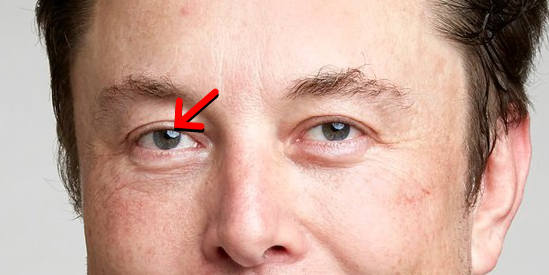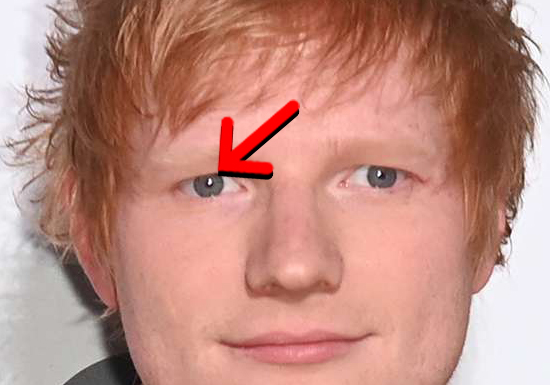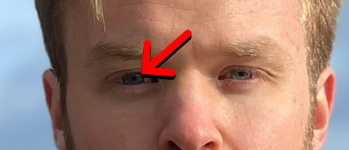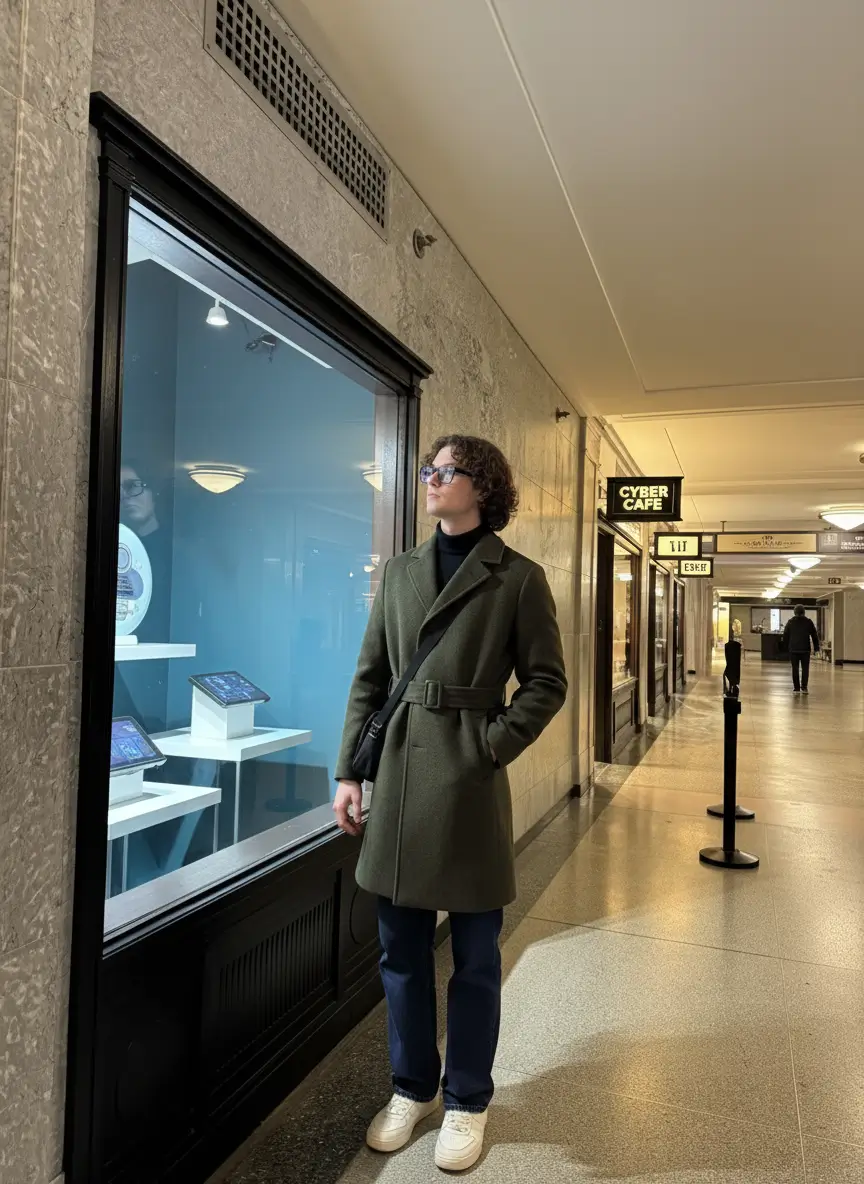The concept of eye dominance in normal subjects, i.e., a consistent preference or advantage for using one of the two eyes, is well known and has been discussed for decades. [1]
Or well, millennia: Some mentions of eye dominance date back to the Greek genius Aristotle 2,300 years ago. [2]
Nevertheless, 'why' we have a dominant eye is currently not known or well-discussed.
In this article, you'll discover:
- How to best tell which eye is your dominant eye. We have a quick test that will give you a rapid answer in 60 seconds or less.
- Why we have a dominant eye - based on new scientific findings.
- And when a dominant eye is benevolent - and when it is something to worry about.
The 60-Second Test To Find Your Dominant Eye
You see this picture of Elon Musk?

Which eye is likely his dominant eye? Let's zoom right in:

The right eye is Elon Musk's dominant eye.
Why? You see that his right eye is staring directly at the camera. While his left eye is deviated.
We also see that Elon Musk has a slight lazy eye (strabismus). [3]
You can see that the left eye is slightly deviated because the reflection of the light looks different on the eye. The reflections are highlighted in this picture:

Now, let's see which is the dominant eye - and non dominant eye - in Ed Sheeran's case?

The right eye is the dominant eye. And the left eye is the non dominant eye. Right?

Again, Ed Sheeran is displaying a slight lazy eye (strabismus). [4]
The Quickest Dominant Eye Test
If you too, are suffering from a slight lazy eye - you'll notice that determining your dominant eye can be done in less than 60 seconds.
Here's the quickest dominant eye test:
- Open your photos (gallery) on your phone.
- Look at selfies or pictures you've taken with other people.
- Which eye of you is staring directly at the camera? That is your dominant eye.
The best way to find out which eye is staring at the camera is again, looking at the light reflections of the eye (similar as we did with Elon Musk above).
The reason this simple and quick test works is that this is a naturally, non-enforced sighting dominant eye test. The camera is a distant object, and the brain will sometimes have a strongly preferred eye.
Which Eye Is Usually Your Dominant Eye?
Most people have their right eye as their dominant eye. A recent study found that the right eye is dominant in up to 70.5% of all cases. [5]
So before you even do a dominant eye test, the chances is high that your right eye is your dominant eye.
Why does this happen? It's thought that the nerve that carries visual information from the right eye goes directly to the part of the brain that processes visual information, while the nerve from the left eye crosses over with the nerve from the right eye before reaching the brain. As a result, the brain tends to favor the information coming from the right eye.
Is It Rare To Be Left Eye Dominant?
No, it is not rare to be left eye dominant.
About one in ten people is left-handed and one in three is left-eyed. [6]
- The chances of you being right eye dominant is about 70%.
- And the chances of you being left eye dominant is about 30%.
A rare condition is usually 1 in 1,500. [7] Not one in 3.
So no, a dominant left eye is not rare.
Is It Good To Have A Dominant Eye?
Yes and no. While having a dominant eye is a natural and normal aspect of human vision, an excessively dominant eye such as we've seen in Elon Musk and Ed Sheeran can lead to (or already is) permanent strabismus and amblyopia. [8]
Amblyopia (also called lazy eye) is a type of permanent poor/blurry vision that usually happens in just 1 eye. [9]
How Do You Know If Both Of Your Eyes Are Dominant?
The less the previous dominant eye test (with the camera) has worked for you, the better. In the following picture, you see a German rapper that has almost perfectly aligned eyes:

If you look very closely, you might notice that his true dominant eye is his left eye. But it's super hard to tell. That is good.
If your eyes are in proper alignment, typically - the less strong your dominant eye is - and the better your eyes work together. [10]
Typically, the more you can see a dominant one eye of you is, the less likely you're able to see in 3d and have depth perception. [11]
Eye Dominance: When To Worry

It's now believed that an eye is a dominant eye on a continuum. Meaning: It's not like an on-off switch, but it gets gradually worse.
The more dominant a given eye is, the more likely it is that you suffer from amblyopia now or in the near future: [12]
The Eye Dominance Continuum
- If you can barely distinguish your dominant eye, you have nothing to worry about.
- If you have a slight lazy eye, it might be beneficial to do a few eye exercises regularly to re-gain control and prevent it from worsening. [13]
- If you have a strong lazy eye, it might be beneficial to opt for vision therapy in the comfort of your home or surgery.
You can strongly reduce eye dominance with the right training.
Multiple studies reinforce the notion that the adult binocular visual system retains its plasticity. Meaning: Your brain - and the wiring of your visual cortex - changes with training. [14], [15]
If You Have A Lazy Eye - Which Eye Is Your Dominant Eye?
If you already suffer from amblyopia (the last stage of eye dominance)...
... like me (the author of this post)...
... then typically the dominant eye has worse visual acuity (sees more blurry) than the other. [16]

In the above picture of yours truly you'll notice that the right eye is slightly misaligned.

As a result:
- The left eye is my dominant eye.
- And the left eye only has lost most - 80% of its vision - overnight, when I was a teenager.
Can You Fix Strong Eye Dominance?
One of the ways to improve one eye dominance is eye patching. [17]
But eye patching is awkward socially, feels awkward for you - and often requires a doctor's supervision (rightfully so, in severe cases).
As a result, to improve the working together of your eyes at home, I've teamed up with a leading Ai developer to create the Lazyeyefix software.
The Lazyeyefix Ai Software For Eye Dominance
The artificial intelligence based Lazyeyefix software improves your eye angle in the comfort of your home.
It's a software that accesses your webcam - similar to Zoom, or Skype - and then analyzes your video to tell you exactly how aligned your eyes are.
- If the angle of your eyes are between 0 - 4 prism diopters, you do not have to worry as your eye is very slightly dominant - and your stereopsis works well.
- If the angle of your eyes are between 4-10 prism diopters, you do have a slight lazy eye and you should continue improving your condition.
- If the angle of your eyes are 10 prism diopters or more, you should use the software regularly and potentially consult with an eye doctor.
You can download an absolutely free trial and find out how dominant your eye is by clicking the link below:
References:
[1] Ocular dominance in human adults.:
https://psycnet.apa.org/record/1930-04631-001
[2] Early studies of eye dominances:
https://psycnet.apa.org/record/1999-11615-001
[3] Strabismus by Cleveland Clinic:
https://my.clevelandclinic.org/health/diseases/15065-strabismus-crossed-eyes
[4] Strabismus by Cleveland Clinic:
https://my.clevelandclinic.org/health/diseases/15065-strabismus-crossed-eyes
[5] Ocular Dominance and Visual Function Testing:
https://pubmed.ncbi.nlm.nih.gov/24319677/
[6] Handedness and eye-dominance: a meta-analysis of their relationship:
https://pubmed.ncbi.nlm.nih.gov/15513026/
[7] What makes a disease rare?
https://www.cslbehring.com/vita/2022/what-makes-a-disease-rare
[8] A push-pull treatment for strengthening the 'lazy eye' in amblyopia:
https://pubmed.ncbi.nlm.nih.gov/23618663/
[9] The Amblyopia Treatment Studies: Implications for Clinical Practice:
https://www.ncbi.nlm.nih.gov/pmc/articles/PMC5396957/
[10] Maximum Angle of Horizontal Strabismus Consistent With True Stereopsis:
https://pubmed.ncbi.nlm.nih.gov/14970796/
[11] A binocular perimetry study of the causes and implications of sensory eye dominance:
https://www.ncbi.nlm.nih.gov/pmc/articles/PMC3225488/
[12] Sensory Eye Dominance: Relationship Between Eye and Brain:
https://pubmed.ncbi.nlm.nih.gov/32021530/
[13] Variability of control in intermittent exotropia:
https://pubmed.ncbi.nlm.nih.gov/17629562/
[14] Sensory Eye Dominance: Relationship Between Eye and Brain:
https://pubmed.ncbi.nlm.nih.gov/32021530/
[15] The shift in ocular dominance from short-term monocular deprivation exhibits no dependence on duration of deprivation:
https://pubmed.ncbi.nlm.nih.gov/30459412/
[16] Association of ocular dominance and anisometropic myopia:
https://pubmed.ncbi.nlm.nih.gov/15277513/
[17] The shift in ocular dominance from short-term monocular deprivation exhibits no dependence on duration of deprivation:






